towing Lexus GS350 2016 Owner's Manual
[x] Cancel search | Manufacturer: LEXUS, Model Year: 2016, Model line: GS350, Model: Lexus GS350 2016Pages: 624, PDF Size: 15.29 MB
Page 3 of 624
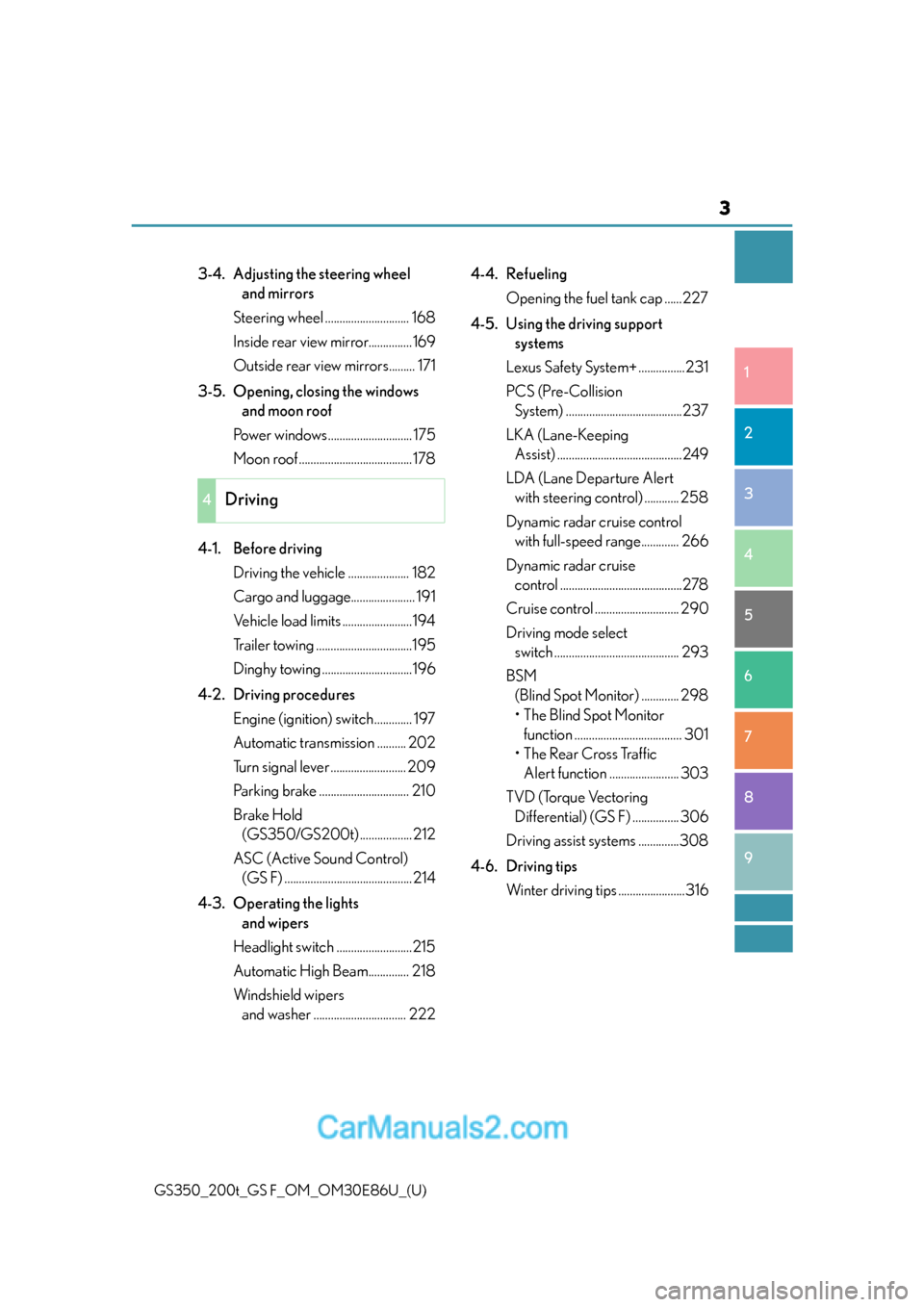
3
1
8 7
6
5
4
3
2
GS350_200t_GS F_OM_OM30E86U_(U)
9
3-4. Adjusting the steering wheel and mirrors
Steering wheel ............................. 168
Inside rear view mirror...............169
Outside rear view mirrors......... 171
3-5. Opening, closing the windows and moon roof
Power windows ............................. 175
Moon roof ....................................... 178
4-1. Before driving Driving the vehicle ..................... 182
Cargo and luggage...................... 191
Vehicle load limits ........................194
Trailer towing .................................195
Dinghy towing ...............................196
4-2. Driving procedures Engine (ign ition) switch ............. 197
Automatic transmission .......... 202
Turn signal lever .......................... 209
Parking brake ............................... 210
Brake Hold (GS350/GS200t) ..................212
ASC (Active Sound Control) (GS F) ............................................214
4-3. Operating the lights and wipers
Headlight switch ..........................215
Automatic High Beam.............. 218
Windshield wipers and washer ................................ 222 4-4. Refueling
Opening the fuel tank cap ......227
4-5. Using the driving support systems
Lexus Safety System+ ................231
PCS (Pre-Collision System) ........................................237
LKA (Lane-Keeping Assist) ...........................................249
LDA (Lane Departure Alert with steering co ntrol) ............ 258
Dynamic radar cruise control with full-speed range............. 266
Dynamic radar cruise control ..........................................278
Cruise control ............................. 290
Driving mode select switch ........................................... 293
BSM (Blind Spot Monitor) ............. 298
• The Blind Spot Monitor function ..................................... 301
• The Rear Cross Traffic
Alert function ........................ 303
TVD (Torque Vectoring Differential) (GS F) ................ 306
Driving assist systems ..............308
4-6. Driving tips Winter driving tips .......................316
4Driving
Page 18 of 624

18Pictorial index
GS350_200t_GS F_OM_OM30E86U_(U)
■Instrument panel
Engine switch . . . . . . . . . . . . . . . . . . . . . . . . . . . . . . . . . . . . . . . . . . . . . . . . . . . . . . . . . P. 1 9 7
Starting the engine/changing the modes . . . . . . . . . . . . . . . . . . . . . . . . . . . . . . . . P. 197
Emergency stop of the engine . . . . . . . . . . . . . . . . . . . . . . . . . . . . . . . . . . . . . . . . . .P. 443
When the engine will not start . . . . . . . . . . . . . . . . . . . . . . . . . . . . . . . . . . . . . . . . . . P. 515
Warning messages . . . . . . . . . . . . . . . . . . . . . . . . . . . . . . . . . . . . . . . . . . . . . . .P. 468, 486
Shift lever . . . . . . . . . . . . . . . . . . . . . . . . . . . . . . . . . . . . . . . . . . . . . . . . . . . . . . . . . . . . P. 202
Changing the shift position . . . . . . . . . . . . . . . . . . . . . . . . . . . . . . . . . . . . . . . . . . . . .P. 202
Precautions against towing . . . . . . . . . . . . . . . . . . . . . . . . . . . . . . . . . . . . . . . . . . . . .P. 444
When the shift lever does not move . . . . . . . . . . . . . . . . . . . . . . . . . . . . . . . . . . . . . P. 517
Meters . . . . . . . . . . . . . . . . . . . . . . . . . . . . . . . . . . . . . . . . . . . . . . . . . . . . . . . . . . . . P. 8 6 , 9 2
Reading the meters/adjusting the instrument panel light . . . . . . . . . . . . . P. 86, 92
Warning lights/indicator lights . . . . . . . . . . . . . . . . . . . . . . . . . . . . . . . . . . . . . . . . . . . P. 78
When the warning lights come on . . . . . . . . . . . . . . . . . . . . . . . . . . . . . . . . . . . . . . P. 452
1
2
3
Page 173 of 624
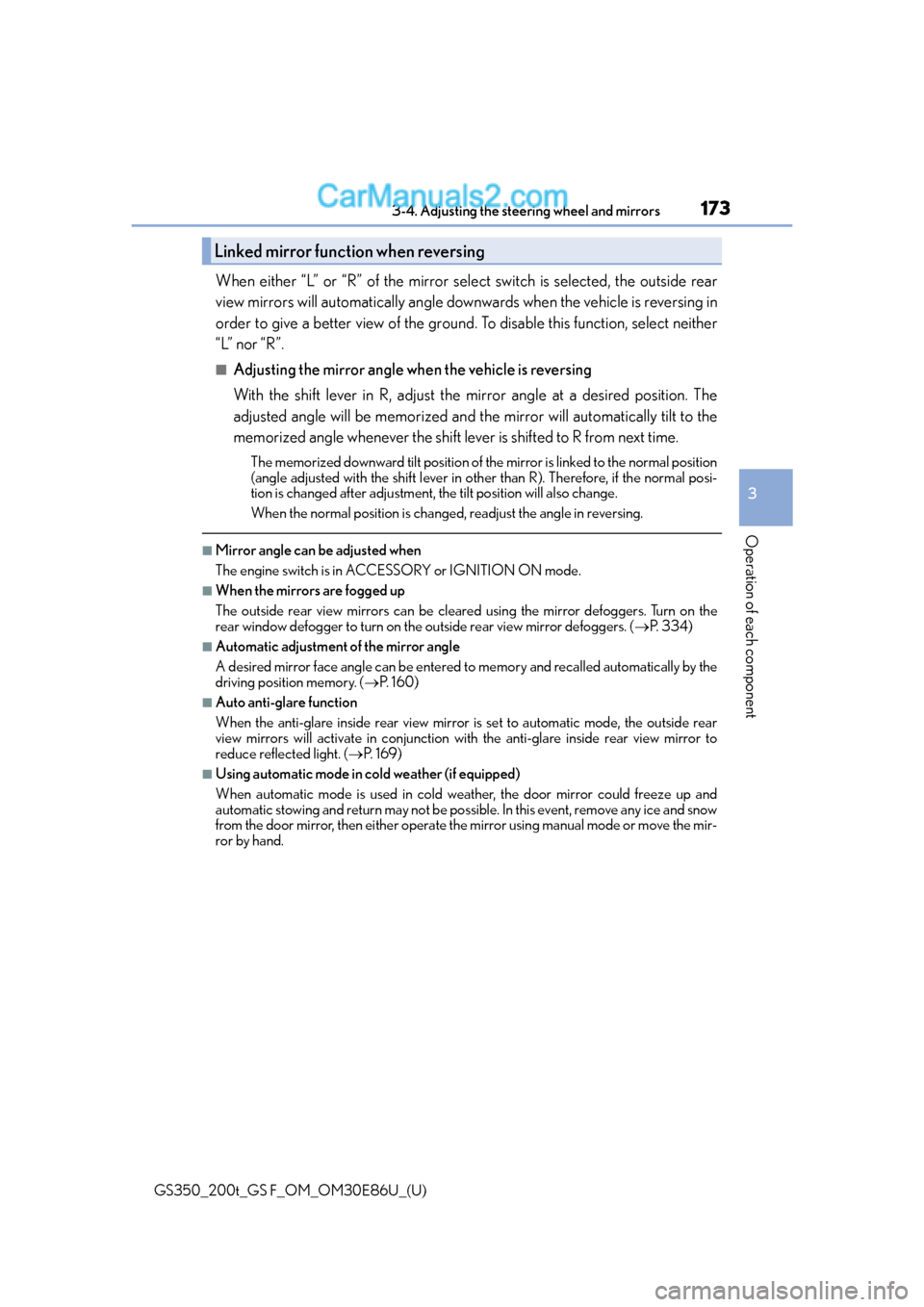
1733-4. Adjusting the steering wheel and mirrors
3
Operation of each component
GS350_200t_GS F_OM_OM30E86U_(U)
When either “L” or “R” of the mirror select switch is selected, the outside rear
view mirrors will automatically angle downwards when the vehicle is reversing in
order to give a better view of the ground. To disable this function, select neither
“L” nor “R”.
■Adjusting the mirror angle when the vehicle is reversing
With the shift lever in R, adjust the mirror angle at a desired position. The
adjusted angle will be memorized and the mirror will automatically tilt to the
memorized angle whenever the shift lever is shifted to R from next time.
The memorized downward tilt position of the mirror is linked to the normal position
(angle adjusted with the shif t lever in other than R). Therefore, if the normal posi-
tion is changed after adjustment, th e tilt position will also change.
When the normal position is chang ed, readjust the angle in reversing.
■Mirror angle can be adjusted when
The engine switch is in ACCESSORY or IGNITION ON mode.
■When the mirrors are fogged up
The outside rear view mirrors can be cleare d using the mirror defoggers. Turn on the
rear window defogger to turn on the outside rear view mirror defoggers. ( P. 3 3 4 )
■Automatic adjustment of the mirror angle
A desired mirror face angle can be entered to memory and recalled automatically by the
driving position memory. ( P. 1 6 0 )
■Auto anti-glare function
When the anti-glare inside rear view mirror is set to automatic mode, the outside rear
view mirrors will activate in conjunction with the anti-glare inside rear view mirror to
reduce reflected light. ( P. 1 6 9 )
■Using automatic mode in cold weather (if equipped)
When automatic mode is used in cold weather, the door mirror could freeze up and
automatic stowing and return may not be possib le. In this event, remove any ice and snow
from the door mirror, then either operate th e mirror using manual mode or move the mir-
ror by hand.
Linked mirror function when reversing
Page 181 of 624
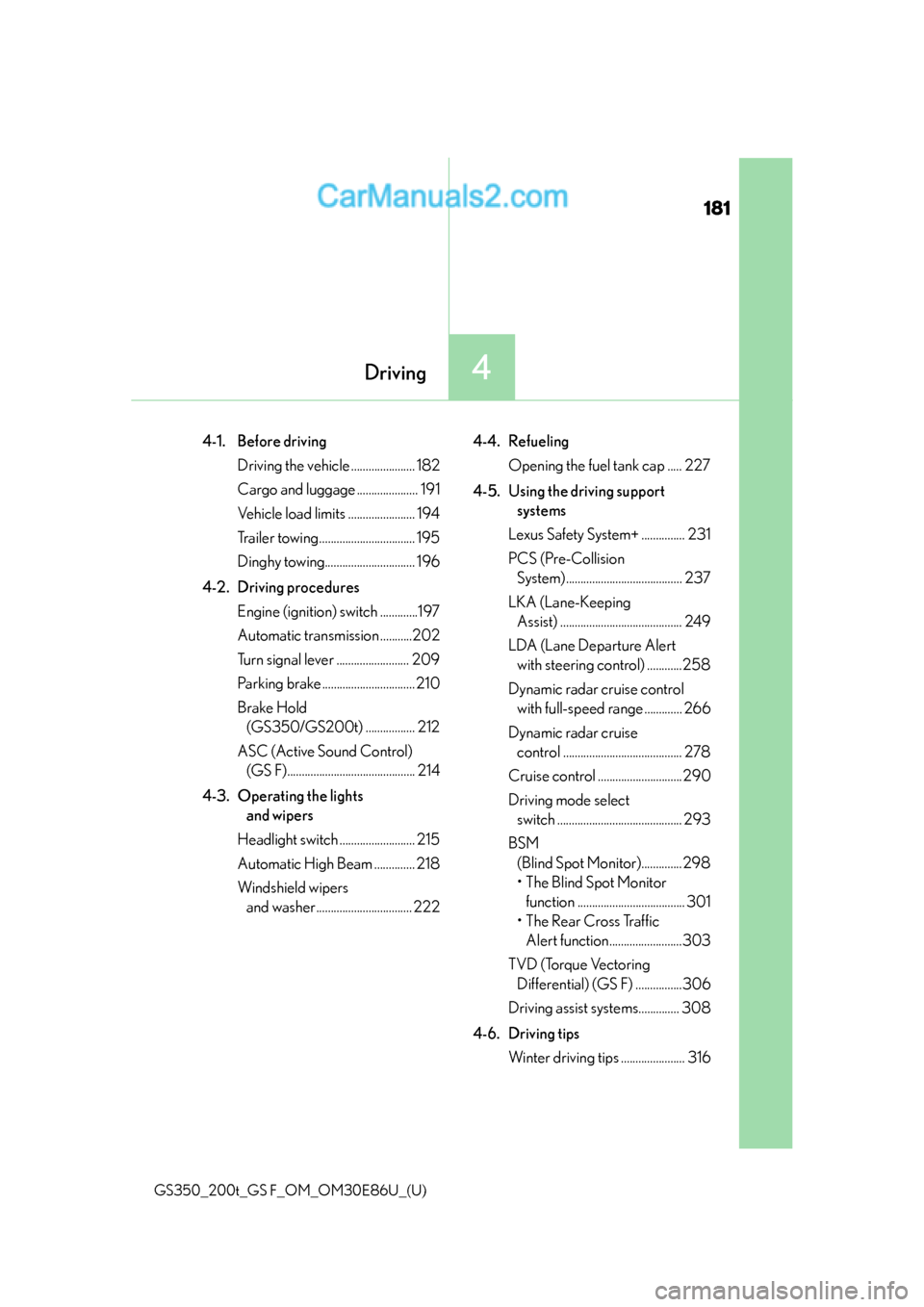
181
GS350_200t_GS F_OM_OM30E86U_(U)
4Driving
4-1. Before drivingDriving the vehicle ...................... 182
Cargo and luggage ..................... 191
Vehicle load limits ....................... 194
Trailer towing ................................. 195
Dinghy towing............................... 196
4-2. Driving procedures Engine (ignition) switch .............197
Automatic transmission ...........202
Turn signal lever ......................... 209
Parking brake ................................ 210
Brake Hold (GS350/GS200t) ................. 212
ASC (Active Sound Control) (GS F)............................................ 214
4-3. Operating the lights and wipers
Headlight switch .......................... 215
Automatic High Beam .............. 218
Windshield wipers and washer ................................. 222 4-4. Refueling
Opening the fuel tank cap ..... 227
4-5. Using the driving support systems
Lexus Safety System+ ............... 231
PCS (Pre-Collision System)........................................ 237
LKA (Lane-Keeping Assist) .......................................... 249
LDA (Lane Departure Alert with steering control) ............258
Dynamic radar cruise control with full-speed range ............. 266
Dynamic radar cruise control ......................................... 278
Cruise control ............................. 290
Driving mode select switch ........................................... 293
BSM (Blind Spot Moni tor)..............298
• The Blind Spot Monitor function ..................................... 301
• The Rear Cross Traffic Alert function.........................303
TVD (Torque Vectoring Differential) (GS F) ................306
Driving assist systems.............. 308
4-6. Driving tips Winter driving tips ...................... 316
Page 191 of 624

191
GS350_200t_GS F_OM_OM30E86U_(U)4-1. Before driving
4
Driving
Cargo and luggage
Cargo capacity depends on the to
tal weight of the occupants.
(Cargo capacity) = (Total load capacity) — (Total weight of occupants)
Steps for Determining Correct Load Limit —
(1) Locate the statement “The combined weight of occupants and cargo should never exceed XXX kg or XXX lbs.” on your vehicle’s placard.
(2) Determine the combined weight of the driver and passengers that will be
riding in your vehicle.
(3) Subtract the combined weight of the driver and passengers from XXX kg or
XXX lbs.
(4) The resulting figure equals the ava ilable amount of cargo and luggage load
capacity.
For example, if the “XXX” amount equals 1400 lbs. and there will be five 150
lb passengers in your vehicle, the am ount of available cargo and luggage load
capacity is 650 lbs. (1400 750 (5 150) = 650 lbs.)
(5) Determine the combined weight of luggage and cargo being loaded on the
vehicle. That weight may not safely exceed the available cargo and luggage
load capacity calculated in Step 4.
(6) If your vehicle will be towing a trailer, load from your trailer will be transferred
to your vehicle. Consult this manual to determine how this reduces the avail-
able cargo and luggage load capacity of your vehicle. (P. 1 9 4 )
Lexus does not recommend towing a trailer with your vehicle. Your vehicle is not
designed for trailer towing.
Take notice of the following information about storage precautions, cargo
capacity and load:
Capacity and distribution
Page 194 of 624
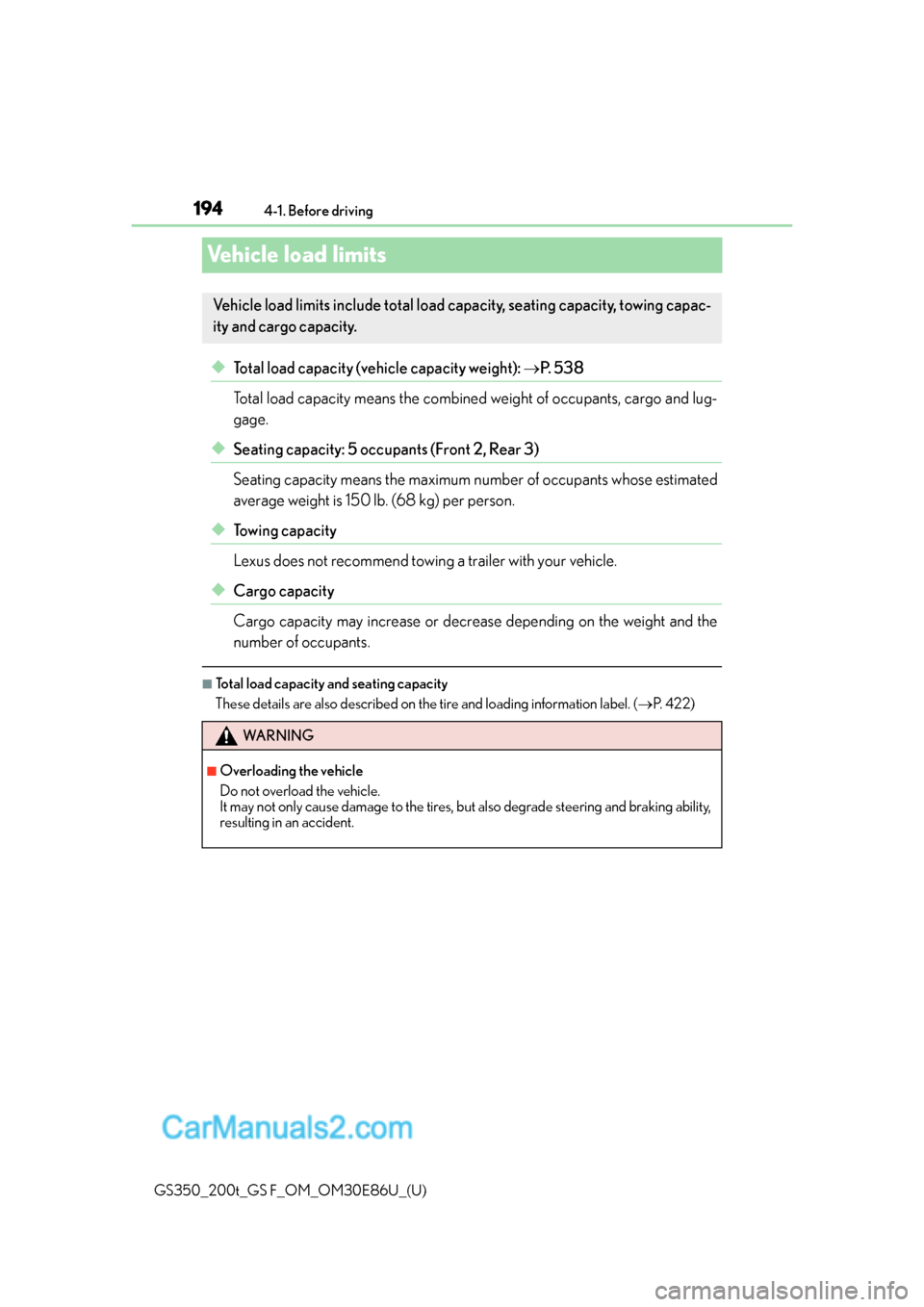
194
GS350_200t_GS F_OM_OM30E86U_(U)4-1. Before driving
Vehicle load limits
◆Total load capacity (vehicle capacity weight):
P. 5 3 8
Total load capacity means the combined weight of occupants, cargo and lug-
gage.
◆Seating capacity: 5 occupants (Front 2, Rear 3)
Seating capacity means the maximum number of occupants whose estimated
average weight is 150 lb. (68 kg) per person.
◆To w i n g c a p a c i t y
Lexus does not recommend towing a trailer with your vehicle.
◆Cargo capacity
Cargo capacity may increase or decrea se depending on the weight and the
number of occupants.
■Total load capacity and seating capacity
These details are also described on the tire and loading information label. (P. 422)
Vehicle load limits include total load capacity, seating capacity, towing capac-
ity and cargo capacity.
WA R N I N G
■Overloading the vehicle
Do not overload the vehicle.
It may not only cause damage to the tires, but also degrade steering and braking ability,
resulting in an accident.
Page 195 of 624

195
GS350_200t_GS F_OM_OM30E86U_(U)4-1. Before driving
4
Driving
Trailer towing
Lexus does not recommend towing a trailer with your vehicle. Lexus also does
not recommend the installation of a tow hitch or the use of a tow hitch carrier
for a wheelchair, scooter, bicycle, etc.
Your vehicle is not designed for trailer
towing or for the use of tow hitch mounted carriers.
Page 196 of 624
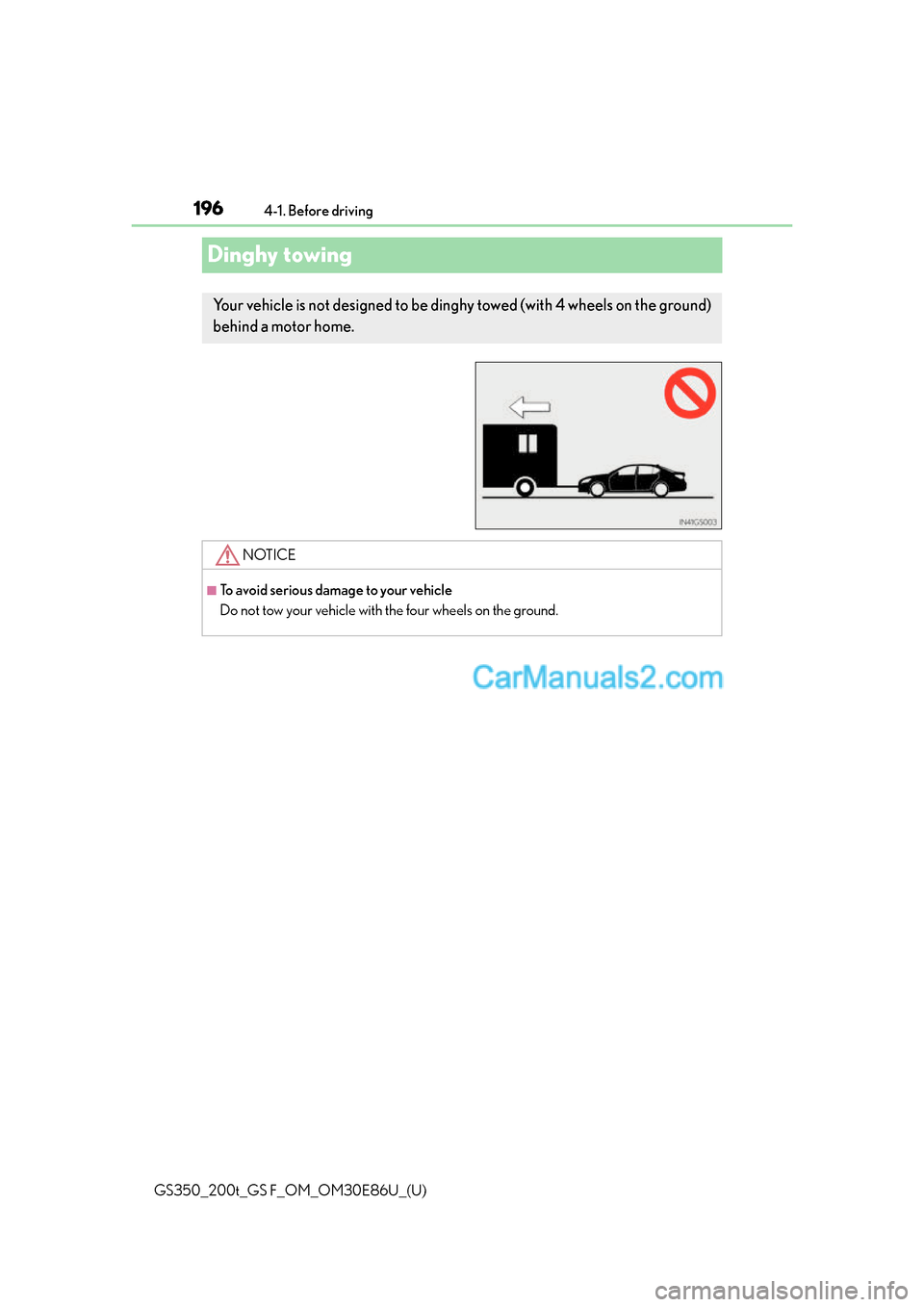
196
GS350_200t_GS F_OM_OM30E86U_(U)4-1. Before driving
Dinghy towing
Your vehicle is not designed to be ding
hy towed (with 4 wheels on the ground)
behind a motor home.
NOTICE
■To avoid serious damage to your vehicle
Do not tow your vehicle with the four wheels on the ground.
Page 239 of 624
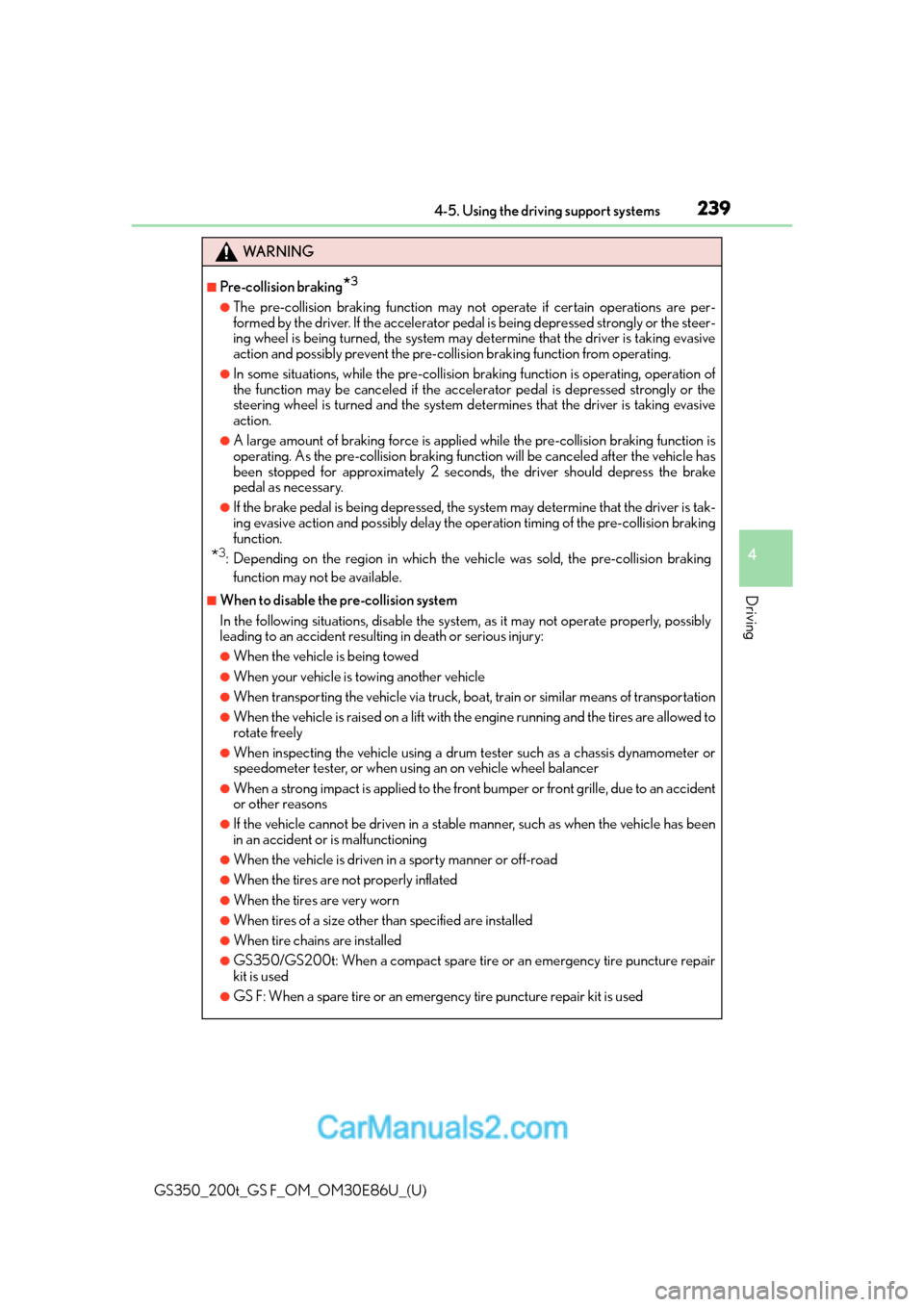
GS350_200t_GS F_OM_OM30E86U_(U)
2394-5. Using the driving support systems
4
Driving
WA R N I N G
■Pre-collision braking*3
●The pre-collision braking function may not operate if certain operations are per-
formed by the driver. If the accelerator pedal is being depressed strongly or the steer-
ing wheel is being turned, the system may de termine that the driver is taking evasive
action and possibly prevent the pre-colli sion braking function from operating.
●In some situations, while the pre-collision braking function is operating, operation of
the function may be canceled if the accele rator pedal is depressed strongly or the
steering wheel is turned and the system determines that the driver is taking evasive
action.
●A large amount of braking force is applied while the pre-collision braking function is
operating. As the pre-collision braking function will be canceled after the vehicle has
been stopped for approximately 2 seconds, the driver should depress the brake
pedal as necessary.
●If the brake pedal is being depressed, the system may determine that the driver is tak-
ing evasive action and possibly delay the op eration timing of the pre-collision braking
function.
*3: Depending on the region in which the ve hicle was sold, the pre-collision braking
function may not be available.
■When to disable the pre-collision system
In the following situations, disable the syst em, as it may not operate properly, possibly
leading to an accident resultin g in death or serious injury:
●When the vehicle is being towed
●When your vehicle is towing another vehicle
●When transporting the vehicle via truck, boat, train or similar means of transportation
●When the vehicle is raised on a lift with the engine running and the tires are allowed to
rotate freely
●When inspecting the vehicle using a drum tester such as a chassis dynamometer or
speedometer tester, or when using an on vehicle wheel balancer
●When a strong impact is applied to the front bumper or front grille, due to an accident
or other reasons
●If the vehicle cannot be driven in a stable manner, such as when the vehicle has been
in an accident or is malfunctioning
●When the vehicle is driven in a sporty manner or off-road
●When the tires are not properly inflated
●When the tires are very worn
●When tires of a size other than specified are installed
●When tire chains are installed
●GS350/GS200t: When a compact spare tire or an emergency tire puncture repair
kit is used
●GS F: When a spare tire or an emerge ncy tire puncture repair kit is used
Page 252 of 624
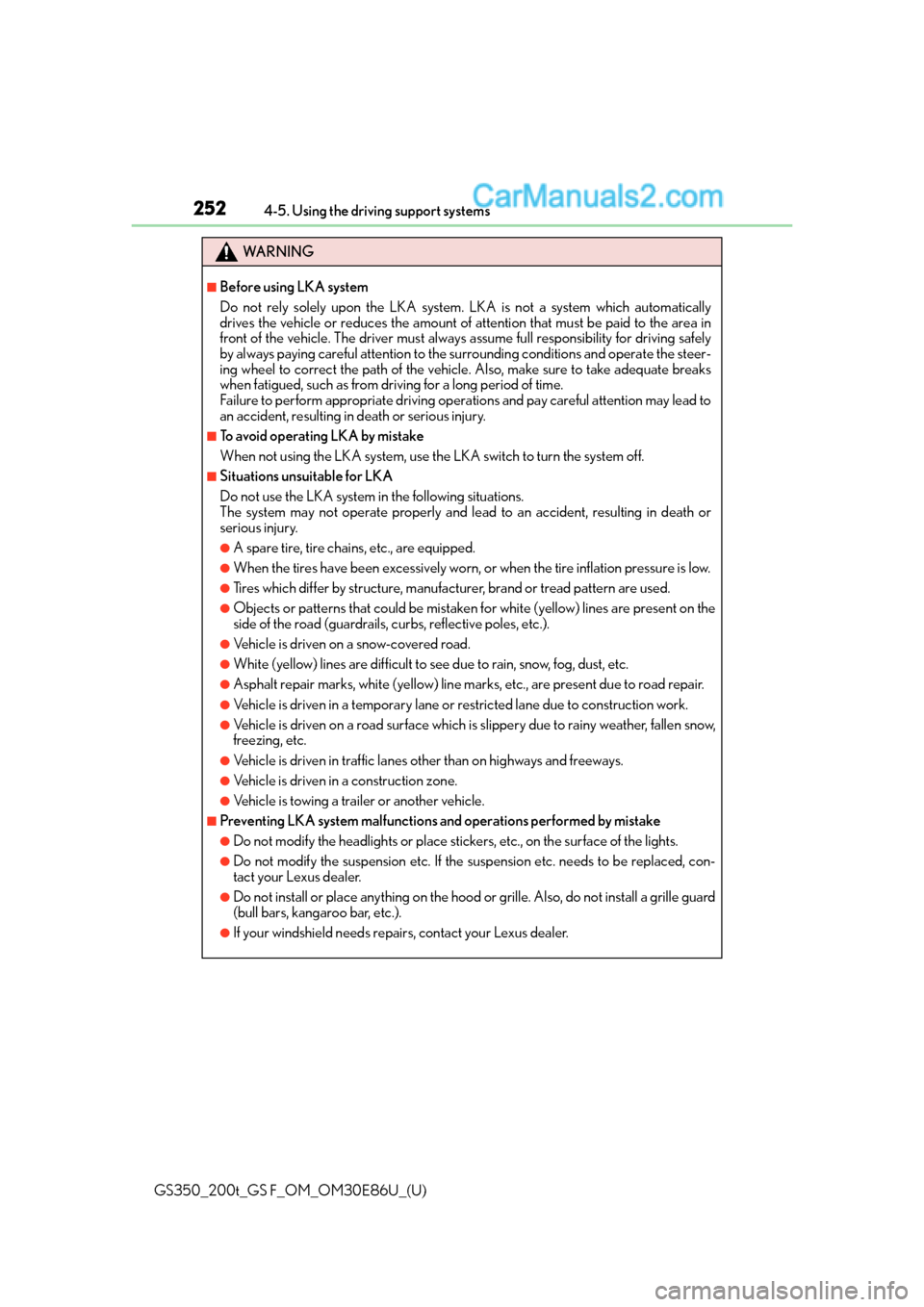
252
GS350_200t_GS F_OM_OM30E86U_(U)4-5. Using the driving support systems
WA R N I N G
■Before using LKA system
Do not rely solely upon the LKA system. LKA is not a system which automatically
drives the vehicle or reduces the amount of
attention that must be paid to the area in
front of the vehicle. The driver must always assume full responsibility for driving safely
by always paying careful attention to the surrounding conditions and operate the steer-
ing wheel to correct the path of the vehicle. Also, make sure to take adequate breaks
when fatigued, such as from driv ing for a long period of time.
Failure to perform appropriate driving operat ions and pay careful attention may lead to
an accident, resulting in death or serious injury.
■To avoid operating LKA by mistake
When not using the LKA system, use the LKA switch to turn the system off.
■Situations unsuitable for LKA
Do not use the LKA system in the following situations.
The system may not operate properly and le ad to an accident, resulting in death or
serious injury.
●A spare tire, tire chains, etc., are equipped.
●When the tires have been excessively worn, or when the tire inflation pressure is low.
●Tires which differ by structure, manufa cturer, brand or tread pattern are used.
●Objects or patterns that could be mistaken for white (yellow) lines are present on the
side of the road (guardrails, curbs, reflective poles, etc.).
●Vehicle is driven on a snow-covered road.
●White (yellow) lines are difficult to see due to rain, snow, fog, dust, etc.
●Asphalt repair marks, white (yellow) line marks, etc., are present due to road repair.
●Vehicle is driven in a temporary lane or restricted lane due to construction work.
●Vehicle is driven on a road surface which is slippery due to rainy weather, fallen snow,
freezing, etc.
●Vehicle is driven in traffic lanes other than on highways and freeways.
●Vehicle is driven in a construction zone.
●Vehicle is towing a trailer or another vehicle.
■Preventing LKA system malfunctions and operations performed by mistake
●Do not modify the headlights or place stickers, etc., on the surface of the lights.
●Do not modify the suspension etc. If the suspension etc. needs to be replaced, con-
tact your Lexus dealer.
●Do not install or place anything on the hood or grille. Also, do not install a grille guard
(bull bars, kangaroo bar, etc.).
●If your windshield needs repairs, contact your Lexus dealer.